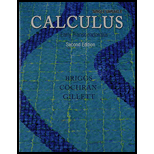
Concept explainers
Growth rates of sequences Use Theorem 8.6 to find the limit of the following sequences or state that they diverge.
64.
Want to see the full answer?
Check out a sample textbook solution
Chapter 8 Solutions
Single Variable Calculus: Early Transcendentals & Student Solutions Manual, Single Variable for Calculus: Early Transcendentals & MyLab Math -- Valuepack Access Card Package
Additional Math Textbook Solutions
Elementary Statistics (13th Edition)
College Algebra (7th Edition)
APPLIED STAT.IN BUS.+ECONOMICS
Elementary Statistics Using The Ti-83/84 Plus Calculator, Books A La Carte Edition (5th Edition)
Introductory Statistics
Elementary and Intermediate Algebra: Concepts and Applications (7th Edition)
- the correct answer is C could you please explainarrow_forwardWhich of the functions shown below is differentiable at z = 2? Select the correct answer below: о -7-6-5-4-3-2- −7 −6 −5 −4 −3-2 1 2 4 5 6 -7-6-5-4-3-2- -7-6-5-4-3 2 45arrow_forwardQuestion Given the graph of f(z) below, find the graph of the derivative of f(z). Select the correct answer below: ° ° 129 -7-6-5-4-3-2 -7-6-5-4-3-2-1123456 ° ° °arrow_forward
- Question Find the open interval(s) of f(x), graph given below, where f'(x) is negative. -3-2-1 1 2 4 5 6 Give your answer in interval notation. For example, (2, 4) U (6,∞). Provide your answer below:arrow_forwardthe correct answer is Ccould you please show me how to do it using the residue theoremarrow_forwardUse the information to find and compare Δy and dy. (Round your answers to four decimal places.) y = x4 + 7 x = −3 Δx = dx = 0.01 Δy = dy =arrow_forward
- Algebra & Trigonometry with Analytic GeometryAlgebraISBN:9781133382119Author:SwokowskiPublisher:Cengage
